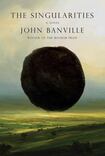
“Who speaks here? I do, little god.” With these words, taken almost verbatim from Ghosts, his 1993 sequel to the Booker Prize-nominated The Book of Evidence, John Banville begins The Singularities. The pilfered line is not accidental.
Banville’s readers will remember that in Ghosts, the murderer Freddie Montgomery, one of the author’s most memorable creations, has been released from prison having served his time. Now self-fashioned as Felix Mordaunt, Freddie returns to his ancestral home of Coolgrange, only to find that it is called Arden House and inhabited by the Godley family, who were first seen in Banville’s 2009 novel The Infinities. And so in The Singularities we do not enter into an alternative sequel to The Book of Evidence so much as step into another alternate dimension in Banville’s universe of fictional possibilities.
Much that is typical of Banville is here. We are in a version of rural Wexford, replete with Big Houses and nostalgia-inducing seaside towns. This is a mythology-enshrouded world, peopled by tweedy Anglo-Norman types, aloof scientists and academics, moody artists and actors, fraudsters, criminals and mountebanks.
Everywhere, things unexpectedly slip and collide
There are two main plotlines. The first, in an echo of The Newton Letter, loosely centres on an academic named William Jaybey’s attempts to write a biography of Adam Godley, a now-deceased world-famous mathematician, while simultaneously falling in love with Godley’s married daughter-in-law Helen. (William Jaybey is of course one of Banville’s puns on his own name.)
READ MORE
The second focuses on Mordaunt’s relegation from the house and his entanglement with Anna Behrens, with whom he had an affair before his imprisonment. These abortive love affairs are mirrored by a third, in which we learn that before he died, Godly had an affair with a young woman named Cass Cleave, a character from Eclipse and Shroud.
Banville has always peopled his narratives with accomplished men of the intellect who are essentially destructive in their pursuit of higher ideals. Their victims in one form or another are usually women: Cleave and Godley’s daughter Petra are driven to suicide; Mordaunt has murdered a maid; Godley’s first wife, we learn, drowned.
We learn too that Godley’s mathematical theories changed the very fabric of reality itself; indeed The Singularities has a speculative element that pushes the narrative in places towards science fiction. Everywhere, things unexpectedly slip and collide. There are numerous shifts in voice and perspective, ranging across varieties of close and omniscient first- and third-person narrators.
Characters from across Banville’s entire oeuvre appear. The boy-genius mathematician Gabriel Swan from Mefisto is there as a spectral presence, suspected of being the real originator of Godley’s world-changing theory, as is Axel Vander, the deconstructionist professor and the Nazi-sympathising impostor from Shroud. These men — Mordaunt, Godley, Swan, Vander — it turns out, moved within each other’s circle, having all worked or spent time in the fictional University of Arcady.
The Singularities is in this sense a synthesis of Banville’s own fiction and a book about what such a synthesis means. It provides a theory not just of itself but of the author’s entire self-contained fictional universe, a deeply textured space that can be endlessly fissured and remade. He is also at his most mischievous: his devotees will have enormous fun hunting for allusions and references to works from his other novels. There are many superb self-referential jokes, including one about Godley being hoaxed into believing he had won a major prize.
It is almost 50 years since the publication of Banville’s second novel, Birchwood, a work that would mark him out as a novelist of great inventiveness (Prospero’s circus, from Birchwood, also appear). Since then, one of the words most commonly used to describe him is “stylist”: critics and commentators have often emphasised the artistry of his prose and his mastery of language. But it is sometimes not remarked upon that Banville is also one of the most substantial Irish writers of the past 50 years. In this book, as in others, he has created a work that meditates in highly sophisticated ways on the nature of reality, existence, knowledge, art, love and death.
And in a literary culture that is dominated by realism, his continued experimentalism marks him out as the most eminent innovator in Irish fiction of the last 50 years. Does it matter here if readers have not read all or any of his other works? It does not. One can linger in the lushness of the prose and admire the extraordinary capaciousness of Banville’s unique imagination.
Eoghan Smith is the author of A Provincial Death and The Failing Heart, both published by Dedalus Books.















